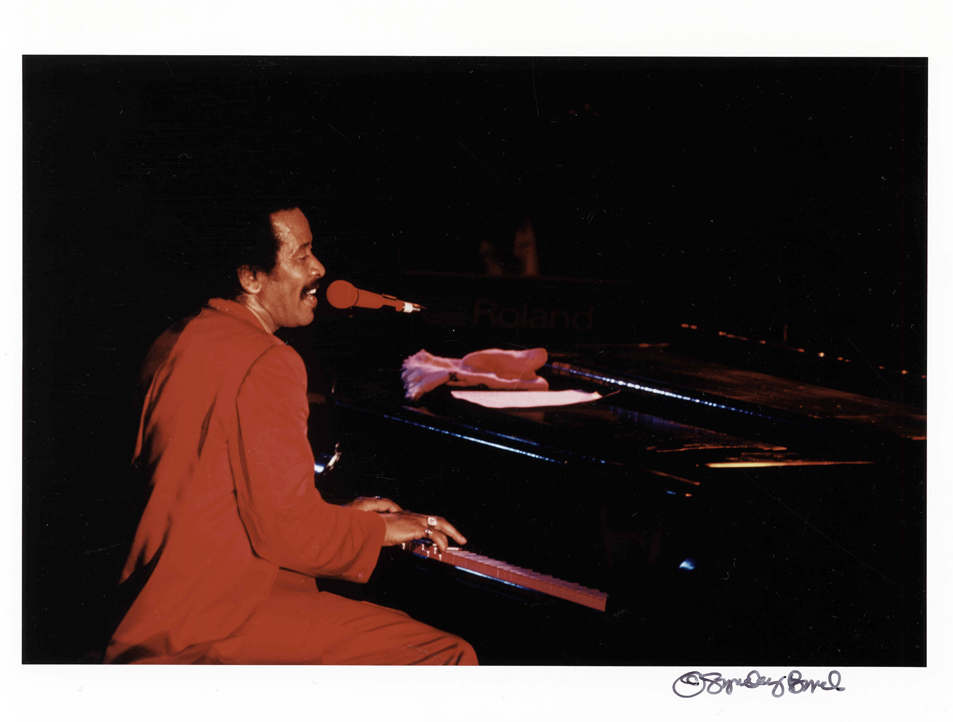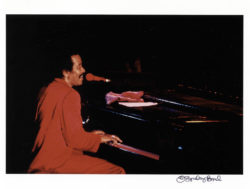Allen Toussaint
Based in New Orleans, Allen Toussaint composed, produced, arranged, and played piano on scores of classic R&B hits from the late 1950s through the 1970s, in addition to recording several solo albums.

LOUISIANA STATE MUSEUM
Allen Toussaint.
Based in New Orleans, Allen Toussaint composed, produced, arranged, and played piano on scores of classic rhythm and blues (R&B) hits from the late 1950s through the 1970s and recorded several solo albums. In many respects, Toussaint’s productions epitomize the sound of 1960s New Orleans R&B. His songs, featuring funky yet sophisticated arrangements and intelligent lyrics, have been recorded by artists in many different musical styles. Considered one of the elder statesmen of New Orleans R&B, Toussaint was inducted into the Rock & Roll Hall of Fame in 1998 and continued to tour and record before his sudden death at the age of seventy-seven due to a heart attack following a performance in Madrid, Spain.
Early Years
Born January 14, 1938, Allen Toussaint grew up in a shotgun house in the Gert Town neighborhood of New Orleans. His father, Clarence Toussaint, was a railroad worker and his mother, Naomi Toussaint, played the piano, which Toussaint took up at an early age. He learned the formal rudiments of classical music from his sister, Joyce, but cites his early influences as boogie-woogie and blues pianists such as Albert Ammons, Ray Charles, Lloyd Glenn, and especially Henry Roeland Byrd, better known as Professor Longhair.
The Toussaint home became an informal meeting and practice space for aspiring musicians and singers in the neighborhood, in part because Naomi Toussaint, a well-known hostess and cook, encouraged young musicians. Allen Toussaint has said that these early sessions were important preparation for his later work as a pianist and arranger. Toussaint formed his first band, The Flamingoes, at age thirteen with guitarist Snooks Eaglin, playing high school dances and parties. The underage Toussaint began sneaking into the legendary New Orleans nightclub the Dew Drop Inn, where many of the city’s finest musicians, known informally as the Dew Drop Set, could be found. He entered the club’s weekly talent shows, where other musicians began to notice his playing. His first big break came in 1955 when Huey “Piano” Smith, who was touring with guitarist Earl King, was unable to make a show in Alabama and Toussaint filled in for him.
Toussaint attended Booker T. Washington High School, as did other New Orleans musicians such as saxophonists James Rivers and Earl Turbinton, guitarist Earl King, and vocalist James “Sugarboy” Crawford, but dropped out in his final year to go on tour with Shirley and Lee. At this young age, Toussaint decided that he would prefer to concentrate on studio work rather than touring. Word spread about the talented young pianist, and Fats Domino’s bandleader Dave Bartholomew hired Toussaint to play piano on a session while Fats was on tour. He was also the arranger on saxophonist Lee Allen’s 1957 instrumental hit “Walkin’ with Mr. Lee.”
In 1958 two talent scouts came to New Orleans to audition singers and musicians. Through this association, Toussaint recorded his first album, The Wild Sound of New Orleans, credited to “Al Tousan” and released on RCA Records. The instrumental LP contained the song “Java,” which was a hit a few years later for trumpeter Al Hirt. Though the album did not sell well at the time, it is now a valuable collector’s item.
Minit/Instant Records
In 1960 Toussaint went to work for Joe Banashak’s Minit Records label, where he began to produce, arrange, and play on an amazing string of chart-topping singles. Minit’s first big hit was Jessie Hill’s “Ooh Poo Pah Doo,” which reached the R&B Top Five in 1960. Their biggest hit was Ernie K-Doe’s “Mother-in-Law,” which hit number one in 1961. Other Minit hits from this era include “Lipstick Traces (On a Cigarette)” and “Fortune Teller” by Benny Spellman, “It Will Stand” by The Showmen, “Over You” by Aaron Neville, and “It’s Raining” by Irma Thomas. Toussaint also produced sessions for other labels, such as “Ya Ya” by Lee Dorsey for the Fury label and “But I Do” by Clarence “Frogman” Henry for Argo. Many of his compositions around this time were credited to “Naomi Neville,” taken from his mother’s maiden name (no relation to the Neville Brothers musical family).
Joe Banashak then signed a distribution deal with Imperial Records but, unhappy with the results, created another label, Instant Records, spawning more Toussaint-arranged hit singles such as Chris Kenner’s “I Like It Like That” and Art Neville’s “All These Things.” Several of the Minit hits were highly influential for early British Invasion bands. For example, the Yardbirds covered “A Certain Girl,” while the Rolling Stones, among others, covered “Fortune Teller.”
Sansu/Sea-Saint Studios
The US Army drafted Toussaint in January 1963, and Toussaint served for two years. While stationed at Fort Hood in Texas, he put together a band of fellow soldiers called The Stokes. While on leave, they went to Houston and recorded a single, “Whipped Cream,” which was later used on the television show The Dating Game and was covered by Herb Alpert on his best-selling 1965 LP Whipped Cream (And Other Delights).
After the US Army discharged Toussaint in 1965, Toussaint formed a production company, Sansu, originally called Cinq Sou (Creole French for “five cents”) with promoter Marshall Sehorn. They released records on a number of subsidiary labels, including Deesu, Kansu, and Tou-Sea. Toussaint’s biggest successes during this period were with Lee Dorsey on singles such as “Ride Your Pony;” “Working in a Coal Mine,” which reached number eight in the summer of 1966; and “Everything I Do Gonh Be Funky (From Now On).” In the late 1960s Toussaint began working with the instrumental funk band The Meters, who provided the backing on many of Sansu’s releases and recorded their own albums as well.
In 1973, desiring a state-of-the-art studio that could compete with facilities in Nashville, Tennessee, and Muscle Shoals, Alabama, Sehorn and Toussaint built Sea-Saint Studios in the Gentilly neighborhood of New Orleans. Toussaint’s productions changed to a harder-edged, more contemporary funk sound on albums by The Meters and The Wild Tchoupitoulas, a New Orleans Mardi Gras Indian tribe. His production of Dr. John’s 1973 LP In The Right Place, with backing by The Meters, featured the number nine single, “Right Place Wrong Time.”
Looking for success on a national stage, Toussaint began to work with a variety of rock, country, and blues artists beyond New Orleans, including The Band, Paul McCartney and Wings, Robert Palmer, Joe Cocker, Etta James, and Albert King. His production of Patti Labelle’s Nightbirds album led to the 1975 number one disco hit “Lady Marmalade.” Glen Campbell had a number one hit with “Southern Nights” in 1977, while Boz Scaggs, Little Feat, Bonnie Raitt, and The Pointer Sisters covered other Toussaint compositions. Even new-wave rockers Devo recorded a version of “Working in a Coal Mine.” During the 1970s, the prolific Toussaint also pursued a solo career, recording four solo albums during the 1970s, first for Scepter Records and later for Reprise.
1980s and Beyond
A 1982 documentary, Piano Players Rarely Ever Play Together, featured Toussaint along with one of his biggest musical influences, Professor Longhair. He also wrote lyrics and music and served as performer, composer, and musical director for Broadway and off-Broadway theatrical productions, notably Staggerlee from 1986 to 1987 and High Rollers Social Aid and Pleasure Club in 1991.
In 1996 Toussaint cofounded NYNO Records to feature local New Orleans talent. His own 1996 album on the label, Connected, was his first full-length release since the 1970s. He also produced, composed, and/or performed on most NYNO releases. He is known for his community and charity work, notably as cofounder of New Orleans Artists Against Hunger and Homelessness with Aaron Neville.
Like all New Orleanians, Hurricane Katrina in 2005 deeply affected Toussaint. Water five feet deep inundated his home, and he sought refuge on the upper floors of a local hotel. He eventually found a ride out of the city, relocating to New York with the help of his NYNO label cofounder, Joshua Feigenbaum. He appeared on the David Letterman Show barely a week after the hurricane hit. With the 2006 release The River in Reverse, a collaboration with British rocker Elvis Costello, Toussaint directly confronted the dislocation and suffering caused by the hurricane. Partially recorded in New Orleans, it was the first major studio recording session held there since Katrina.
One of his most noteworthy talents was his ability to write songs to fit the styles and personalities of different singers. Known for his sartorial flair, his musical perfectionism, his adaptability, and his soft-spoken and elegant demeanor, he enjoyed being behind the scenes. Toussaint’s 1998 induction into the Rock & Roll Hall of Fame in the nonperformer category capped his lengthy list of artistic awards and commendations. His 2009 release on Nonesuch Records, The Bright Mississippi, was the first jazz album of his fifty-year career and received extremely positive reviews. He maintained a limited but active touring schedule while living in New Orleans before he suffered a heart attack while on tour in Madrid, Spain, on November 10, 2015. Nonesuch Records posthumously released his final record, American Tunes, in June of 2016, and in January 2022 the New Orleans City Council voted unanimously to rename Robert E. Lee Boulevard in his honor.
